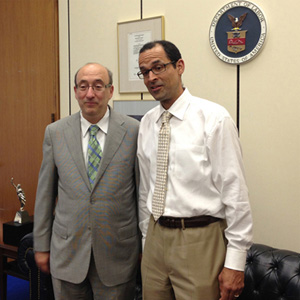
WASHINGTON – Some time ago, Alan White, a worker at Aurubis Copper in Buffalo, N.Y., went to his doctor. He was coughing, hacking and short of breath. And his doctor gave him some pretty bad news.
He has silicosis, caused by 18 years of inhaling silica dust, which can cause cancer, at his foundry. White’s doctor predicted he’d die within three years.
Well, White, a member of Steelworkers Local 593 in Buffalo, is still around, and on August 23 he stood with Dr. David Michaels, administrator of the Occupational Safety and Health Administration (OSHA), as Michaels announced a new proposed federal rule – long pushed by the Steelworkers and other unions – to cut down worker exposure to silica.
“This proposal is expected to prevent thousands of deaths from silicosis – an incurable and progressive disease – as well as lung cancer, other respiratory diseases, and kidney disease. Workers affected by silica are fathers, mothers, sisters and brothers lost to entirely preventable illnesses,” Michaels stated after White told his story.
OSHA estimated the rule would prevent 700 deaths yearly, and 1,600 silicosis cases.
Some 2.2 million workers are exposed yearly to silica, with 1.85 million of them in construction and the rest in general industry, including the maritime trades. The federal government’s current silica exposure standard is based on 50-plus-year-old data, outdated testing methods and was instituted in 1971, Michaels said.
The new limit, which would apply to all workers, limits exposure to silica dust to 50 micrograms of breathable crystalline silica per cubic meter of air, averaged over an 8-hour day, OSHA said. That’s half of the current permitted silica exposure.
“The proposed rule also includes provisions for measuring how much silica workers are exposed to, limiting workers’ access to areas where silica exposures are high, using effective methods for reducing exposures, providing medical exams to workers with high silica exposures, and training for workers about silica-related hazards and how to limit exposure,” the agency added.
“These provisions are similar to industry consensus standards that many responsible employers have been using for years, and the technology to better protect workers is already widely available,” OSHA’s fact sheet about silica notes.
It adds that employers can protect their workers by “common dust control methods, such as wetting down work operations to keep silica-containing dust from getting into the air, enclosing an operation, or using a vacuum to collect dust at the point where it is created before workers can inhale it.
Union leaders welcomed the proposed silica exposure rule, but AFL-CIO President Richard Trumka warned that business might still try to stop it – a common tactic it used against virtually every OSHA plan.
“This rule is long overdue. The development of the silica standard began more than 16 years ago. Meanwhile workers have continued to suffer unnecessary disease and death,” he said.
“Silica dust is a killer. It causes silicosis, a disabling lung disease that literally suffocates workers to death. It also causes lung cancer and other diseases. The current OSHA silica standard was adopted decades ago and fails to protect workers. It allows very high levels of exposure and has no requirements to train workers or monitor exposure levels.
“The proposed rule will cut permitted dust exposure levels in half, require exposure monitoring and medical exams for exposed workers and require implementation of well-established dust control methods, like the use of water and ventilation.
“But this rule is only a proposal – workers exposed to silica dust will only be protected when a final rule is issued. Some industry groups are certain to attack the rule and try to stop it in its tracks. The AFL-CIO will do everything we can to see that does not happen.”
“Regulations like these save lives,” added Steelworkers President Leo Gerard, whose union’s active safety and health department has probed and publicized the dangers of silica exposure. The exposure can be controlled, the Steelworkers state. “The best employers are already doing what OSHA has proposed,” said Gerard. “But everyone deserves protection from deadly workplace diseases.”
All of this will come too late for Alan White, though.
“After a series of tests he told me that I will die from exposure to silica,” White said of the M.D.’s findings. “Eighteen years ago, I was excited to get a job at the foundry. At the time, I was a single parent, making ends meet with assistance from the government. When I got my job at the foundry, I made $62,000 the first year and thought I was set. I was ready and willing to give my all to work. But I never realized that that included my life.”
Photo: Dr. David Michaels from OSHA, left, and USW Local 593 member Alan White. USW website.










